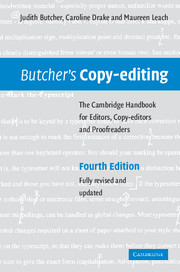Book contents
- Frontmatter
- Contents
- List of illustrations
- Preface to the fourth edition
- Preface to the third edition
- Preface to the second edition
- Preface to the first edition
- Acknowledgements
- 1 Introduction
- 2 Preliminary copy-editing, design and specimen pages
- 3 Preparing the text for the typesetter
- 4 Illustrations
- 5 Proofs
- 6 House style
- 7 Preliminary pages
- 8 Indexes
- 9 Other parts of a book
- 10 Bibliographical references
- 11 Literary material
- 12 Multi-author and multi-volume works
- 13 Science and mathematics books
- 14 Other special subjects
- 15 Reprints and new editions
- 16 On-screen editing
- Appendixes
- 1 Checklist of copy-editing
- 2 Book sizes
- 3 Abbreviations for states in the USA
- 4 Phonetic symbols
- 5 The Russian alphabet
- 6 Old English and Middle English letters
- 7 French and German bibliographical terms and abbreviations
- 8 Mathematical symbols
- 9 Hebrew
- 10 Arabic
- 11 Islamic, Chinese, Japanese and French Revolutionary calendars
- 12 Countries of the former USSR, Baltic states and former Yugoslavia
- 13 Proof correction symbols
- 14 How to check that an ISBN is correct
- Glossary
- Select bibliography and other resources
- Index
11 - Islamic, Chinese, Japanese and French Revolutionary calendars
from Appendixes
Published online by Cambridge University Press: 05 August 2012
- Frontmatter
- Contents
- List of illustrations
- Preface to the fourth edition
- Preface to the third edition
- Preface to the second edition
- Preface to the first edition
- Acknowledgements
- 1 Introduction
- 2 Preliminary copy-editing, design and specimen pages
- 3 Preparing the text for the typesetter
- 4 Illustrations
- 5 Proofs
- 6 House style
- 7 Preliminary pages
- 8 Indexes
- 9 Other parts of a book
- 10 Bibliographical references
- 11 Literary material
- 12 Multi-author and multi-volume works
- 13 Science and mathematics books
- 14 Other special subjects
- 15 Reprints and new editions
- 16 On-screen editing
- Appendixes
- 1 Checklist of copy-editing
- 2 Book sizes
- 3 Abbreviations for states in the USA
- 4 Phonetic symbols
- 5 The Russian alphabet
- 6 Old English and Middle English letters
- 7 French and German bibliographical terms and abbreviations
- 8 Mathematical symbols
- 9 Hebrew
- 10 Arabic
- 11 Islamic, Chinese, Japanese and French Revolutionary calendars
- 12 Countries of the former USSR, Baltic states and former Yugoslavia
- 13 Proof correction symbols
- 14 How to check that an ISBN is correct
- Glossary
- Select bibliography and other resources
- Index
Summary
ISLAMIC
The Muslim calendar is based on a lunar year of approximately 354 days, i.e. eleven days less than a solar year. The Islamic era was established by the Caliph 'Umar and takes as its starting point the flight of the Prophet Muhammad from Mecca to Medina on 16 June 622. Unlike other lunar, calendars, however, the Islamic one does not intercalate a thirteenth month at calculated intervals to keep the lunar months in alignment with the seasons. Thus each Islamic month circulates through the seasons in roughly thirtythree years. There is a conversion table in J. L. Bacharach, A Middle East Studies Handbook (Cambridge University Press, 1984), pp. 8–15, which also provides a detailed explanation of the Islamic calendrical system, a list of the Islamic months, major festivals, etc.
One small problem not directly mentioned by Bacharach arises out of the official adoption in Iran in the early twentieth century of the solar (shamsi) year of 365 days. Although the solar calendar continues to take the Hijra (or Hegira) of the Prophet as its starting point, each solar year begins in March, at the Spring Equinox, so that a conversion to ad dates involves the addition of 621 years for the first nine months of the shamsi year and 622 for the last three months, e.g. 1350 shamsi ran from March 1971 to March 1972.
If Islamic dates stand alone they should be identified, e.g. ah 1382, s. 1341.
- Type
- Chapter
- Information
- Butcher's Copy-editingThe Cambridge Handbook for Editors, Copy-editors and Proofreaders, pp. 475 - 477Publisher: Cambridge University PressPrint publication year: 2006



